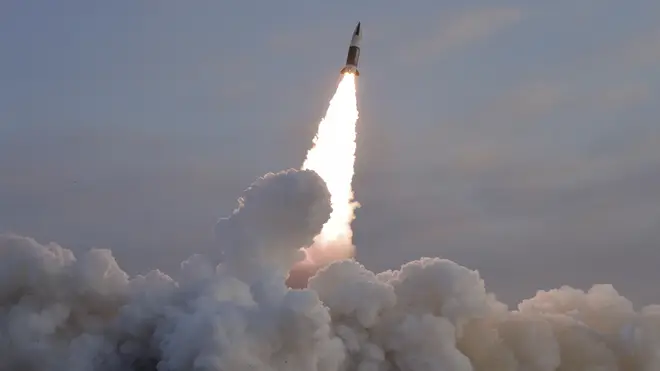
Clive Bull 1am - 4am
27 January 2022, 10:54

Experts say the dictatorship’s unusually fast pace in testing activity underscores an intent to pressure the Biden administration.
North Korea has fired two suspected ballistic missiles into the sea in its sixth round of weapons launches this month, South Korea’s military said.
Experts say North Korea’s unusually fast pace in testing activity underscores an intent to pressure Washington over long-stalled negotiations aimed at exchanging a release of crippling US-led sanctions against Pyongyang and the North’s denuclearisation steps.
The renewed pressure comes as the pandemic further shakes the North’s economy, which had already been battered by sanctions over its nuclear weapons programme and decades of mismanagement by its own government.
South Korea’s Joint Chiefs of Staff said the weapons, which were likely to be short-range, were launched five minutes apart from the eastern coastal town of Hamhung and flew 190 kilometres (118 miles) on an apogee of 20 kilometres (12.4 miles) before landing at sea.

Aviation authorities issued a Notice to Airmen, or NOTAM, for pilots operating in South Korean air space, advising them of a “missile launched from North Korea” and to maintain close communication with air traffic controls, according to the website of South Korea’s Office of Civil Aviation.
The US Indo Pacific Command said the latest launches highlighted the destabilising impact of North Korea’s weapons programme, but did not pose an “immediate threat to US personnel or territory, or to our allies”.
Japan said the missiles did not reach its exclusive economic zone and there were no reports of damage to vessels or aircraft around its coast.
Prime Minister Fumio Kishida said the North’s repeated missile firings were “extremely regrettable” and violated UN Security Council resolutions.
Senior South Korean security and military officials gathered for an emergency National Security Council meeting where they expressed strong regret over the North’s continuing launches and urged Pyongyang to recommit to dialogue, Seoul’s presidential office said.
The North last week issued a veiled threat to resume the testing of nuclear explosives and long-range missiles targeting the American homeland, which leader Kim Jong Un suspended in 2018 while initiating diplomacy with the US.

Mr Kim’s high-stakes summits with then-president Donald Trump derailed in 2019 after the Americans rejected North Korea’s demands for major sanctions relief in exchange for a partial surrender of its nuclear capabilities.
Some experts say Pyongyang could dramatically escalate weapons demonstrations after the Winter Olympics, which begin on February 4 in China, the North’s main ally and economic lifeline.
They say Pyongyang’s leadership is likely to feel it could use a dramatic provocation to move the needle with the Biden administration, which has been preoccupied with bigger adversaries including China and Russia.
The Biden administration has offered open-ended talks but showed no willingness to ease sanctions unless Mr Kim takes real steps to abandon the nuclear weapons and missiles he sees as his strongest guarantee of survival.
The North has been ramping up its testing activity since last autumn, demonstrating various missiles and delivery systems apparently designed to overwhelm missile defence systems in the region.
Experts say Mr Kim is trying to apply more pressure on rivals Washington and Seoul to accept it as a nuclear power in hopes of winning relief from economic sanctions and converting the diplomacy with Washington into mutual arms-reduction negotiations.
Thursday’s launch came two days after South Korea’s military detected the North flight-testing two suspected cruise missiles at an unspecified inland area.
North Korea opened 2022 with a pair of test-firings of a purported hypersonic missile, which Mr Kim described as an asset that would bolster his nuclear “war deterrent”.
The North also this month test-fired two different types of short-range ballistic missiles it has developed since 2019 that are designed to be manoeuvrable and fly at low altitudes, which experts say potentially improves their chances of evading and defeating missile defence systems.